The World Around Us
You can help your children find out more about the world round us with these interactive activities.
If you go out for a walk today, you’re sure for a big surprise! – Mairead McElroy
This is a great activity for exploring further a topic your child might be learning or a particular interest they have.
Learning Intentions:
- Using Google 3D animals, develop children’s creativity, imagination and ICT skills in creating a story.
Activity:
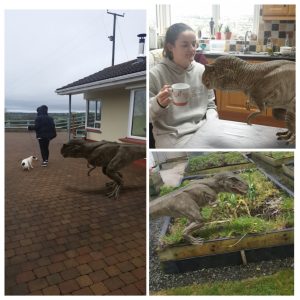 Depending on the topic or interest enter into google ‘Google 3D Animals’ there you will find a list of animals or objects you can search for in your google search.
Depending on the topic or interest enter into google ‘Google 3D Animals’ there you will find a list of animals or objects you can search for in your google search.- Once you have picked one, type it into the google search bar and click the option view in 3D there your animal/object will virtually appear on your camera.
- If you wish to take a picture you can click once or if you want to take a video, hold in the shutter for the duration of your video.
- Encourage children to create a story using the images they have made along the way to explain the evolution of your story or capture it through a short video.
- The example shown tells the story of a dinosaur I met walking my dog, who was a plant eating dinosaur and followed me home to my house. Your child’s imagination could take the story anywhere, which is supporting their creativity.
Progression/Follow Up Activity:
- Encourage children to think of their favourite story and see if they can retell it through pictures of their Google 3D animal. For example, ‘The Tiger who came to tea’ ‘We’re Going on a Bear hunt’.
Winter Watch – Heather McKee
So as the cold weather is upon us and the ground begins to freeze, some of our feathered friends may have difficulty finding a source of food. So why don’t we give them a helping hand!
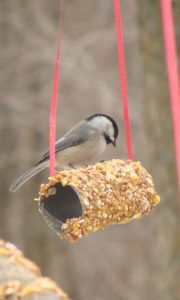 Learning Intention
Learning Intention
How do living things survive?
Resources
Toilet roll tubes, peanut butter, bird seed, string and a knife and/or spoon (allergy alternative to peanut butter – lard or butter).
Activity
1. Cover the toilet roll tube in peanut butter, lard or butter.
2. Roll the covered toilet roll tube in bird seed.
3 Cut a long piece of string and place it through the toilet roll tube and tie at the top.
4. Hang on a branch on a tree in the garden and observe the winter birds that come to eat.
5 Discuss how you and your child have made it easier for the winter birds to find food.
Go on a Listening Walk! – Eirinn McCrudden
While walking around your community or a park, talk about/ take photos of/ list different sounds you can hear. Are they loud or quiet? Long or short?
Learning Intention:
Identify environmental sounds, predicting and describing what they hear and what children think might be making the noise.
Activity:
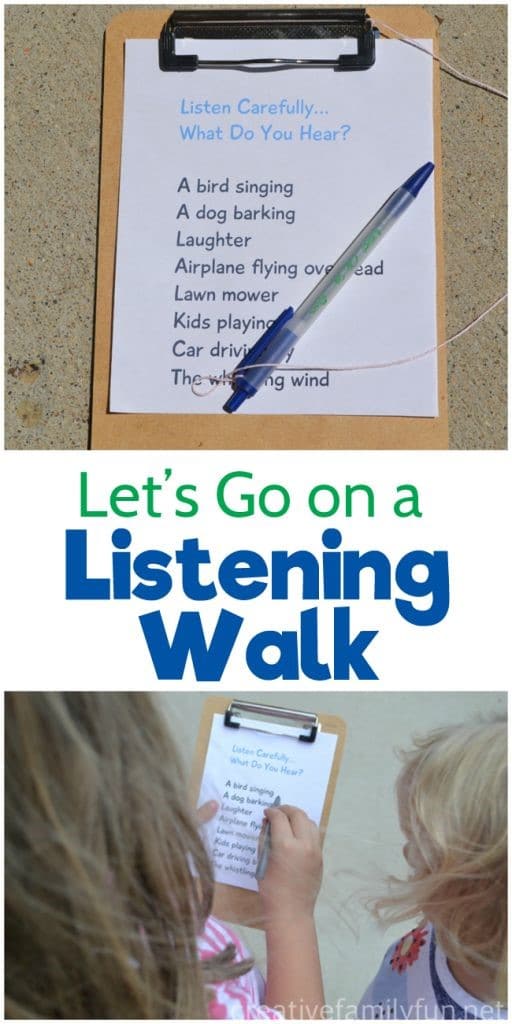 1. Before your walk with your child, explain to them what the activity is and that you will using your listening ears to investigate different sounds. Perhaps you could help your child make a list or draw pictures of things your child thinks they might be able to hear on the walk.
1. Before your walk with your child, explain to them what the activity is and that you will using your listening ears to investigate different sounds. Perhaps you could help your child make a list or draw pictures of things your child thinks they might be able to hear on the walk.
2. Go out for a walk with your child either around your community or in a park. Talk about where sounds may be coming from or count how many you can hear.
3. While out on your walk, let your child take the lead and go with their ideas for sounds. Although don’t be afraid to share your ideas too! If your child is more reserved, you can ask some open-ended questions to stimulate their thinking. Such as:
- “I think I heard something. Did you hear it too?”
- “I wonder what it could be/ where it came from”
- “If we listen carefully, we might hear something quiet”
4. Discuss with your child the different sounds you can hear. Investigate to find out where the sounds are coming from and talk through why you think this. Talk about if it’s a loud or quiet sound and maybe if your child could recreate it! You could also take photos or make a list of all the sounds you hear.
Extension: When home, see if your child can remember what sounds they heard. They could draw a picture of where you walked together and what they heard.
A Superhero Like You Story – Jason Mclean
This story allows your child to understand the world around them. They discover the different jobs that grown-ups do in order to help others. It shows a great sense of being kind and caring to each other, whilst helping each other.
Learning Intentions
Listen to the story and take part in discussion on what Superhero’s are in the book. Also be able to use language and identify what each Superhero does, during their job.
Required Resources
The story can be accessed through the recorded video or it can also be found on you tube.
Activity
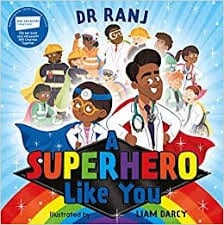 1. Let children listen to the story “A Superhero Like You”.
1. Let children listen to the story “A Superhero Like You”.
2. Ask the children to name the different Superhero’s that were in the book. Talk about how helpful each superhero was. How different/similar they were. Ask them what Superhero they would like to be when they grow up?
Extension
Create their own superhero’s either by drawing, writing or making using junk items.
Playdough Animals – Amy Woods
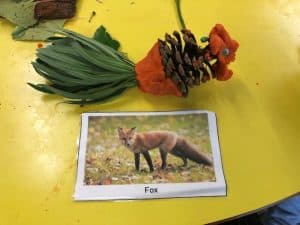 Enjoy time with your children creating animals using natural materials found outdoors.
Enjoy time with your children creating animals using natural materials found outdoors.
Learning Intentions
To explore and experiment with a variety of natural materials to make prints on playdough, create animals using various natural materials and learn about concepts such as noctural behaviour and hibernation.
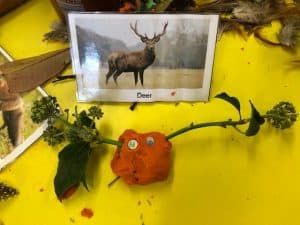 Activity
Activity
1. Resources: playdough, variety of plants, dough utensils, pictures of animals.
2. Firstly, make playdough with the children (add in mixed spice and paint to make it more sensory and colourful).
3. Go on a scavenger hunt and see what natural resources can be used to add to the playdough to create animals or make prints on the playdough.
Making Bird Food – Louise Orr
Learning Intention
Support children with understanding the need to care for animals in our environment, by feeding the birds during the frosty winter conditions.
Resources
Ideally you could use pipe cleaners although a shoe lace could also be used, you will need Cheerios or a similar cereal will do.
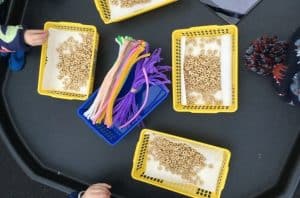 Activity
Activity
1. Place Cheerios loose into a bowl or basket.
2. Support your child with tying a knot at one end of your pipe cleaner/lace, before they begin so the Cheerios stay on.
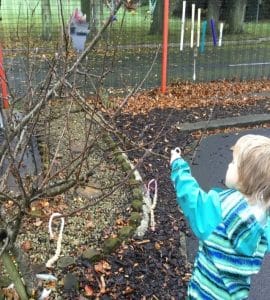 3. Encourage your child as they begin to loop Cheerios onto their pipe cleaner or lace by making one yourself alongside them.
3. Encourage your child as they begin to loop Cheerios onto their pipe cleaner or lace by making one yourself alongside them.
4. When you have completed your bird food, encourage your child to explore the garden to find a suitable place to hang their bird food.
5. Observe what happens over the next few days as the birds begin to eat the food. Encourage your child to describe what they can see happening and why we need to feed the birds during winter.
Winter Day Scavenger Hunt – Aimee McGleenan
Learning Intentions:
To explore natural materials and environments and discuss such elements when using them in an artistic manner
To become more engaged with their natural environment through exploration and questioning
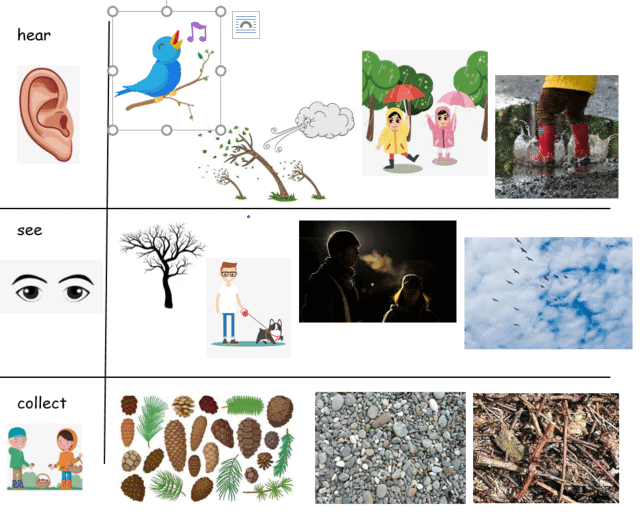
Activity
1. Go for a walk outdoors around your local area and take in your surroundings.
2. Once you arrive back home, arrange your collection on your whiteboard, or on a sheet of paper. If you would like to stick the items on the paper, you will also need some glue.
3. What kind of shapes have you made? What kind can you make?
4. Have you made something you seen on your walk?
5. How do they feel? Are they cold or wet? Are they dry and brittle? Or heavy? Are they shiny or smooth?
6. What do they look like? Are they the same colour? Are they bigger or smaller than each other? Are the twigs and sticks long?
Grow a Rainbow – Eirinn McCrudden
Discover how to grow a rainbow using water, kitchen roll and markers!
Learning Intention:
Children should be able to explore what kind of changes might happen and investigate and talk about colours
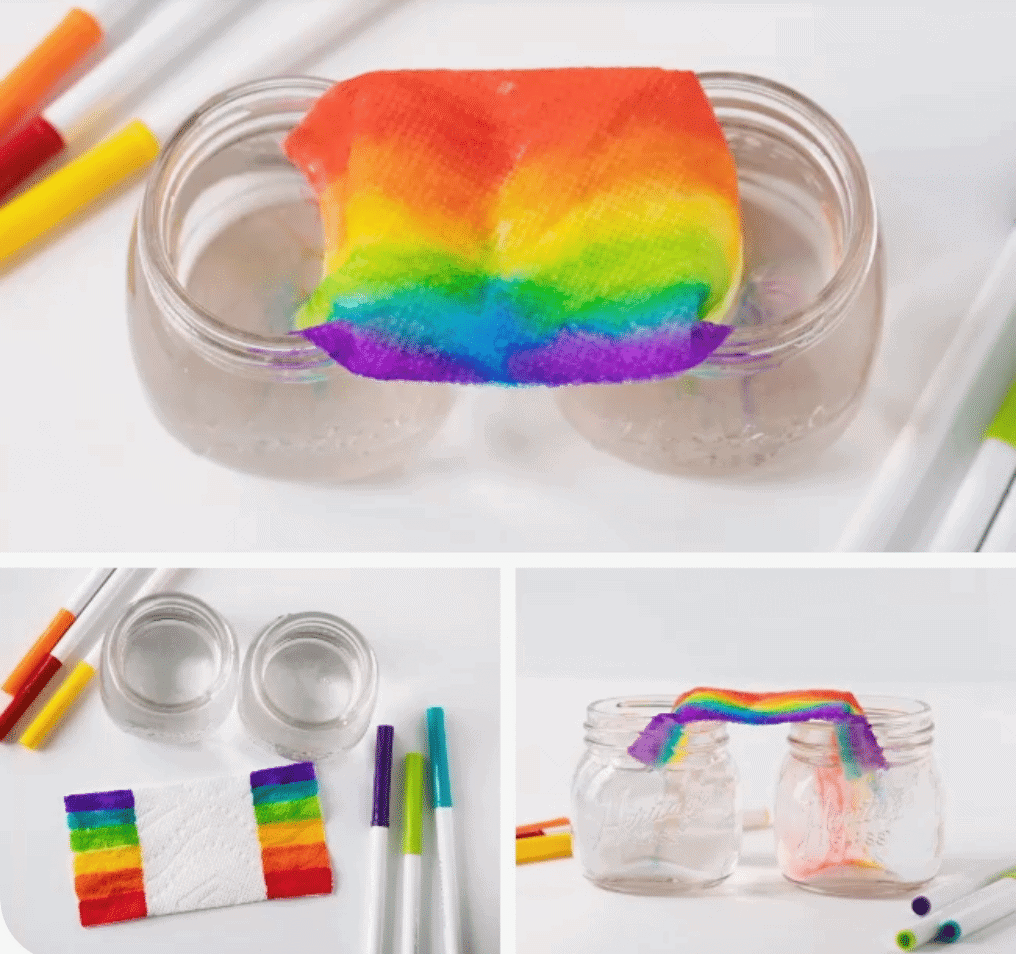 Activity:
Activity:
1. You will need 2 jars, containers, bowls or anything you have available to add some water to. You will also need a sheet of kitchen roll and markers in the colours of the rainbow
2. Fold the kitchen roll sheet in half and cut shorter if needed. Colour each end of the kitchen roll sheet like in the photo to the left in each colour of the rainbow (or whatever colours you have available!)
3. Fill your jars (or whatever you’re using) with some water. Place each end where your child has coloured into the jar and sit back to watch the magic happen!
4. To further your child’s thinking, ask what they think will happen before you do the experiment and what they see happening during and why.
Extension: Another way to do this experiment is to use the sweets, Skittles! Place skittles around the inner circle on a plate- being sure to use a different colour each time! (maybe your child could make a pattern) Pour some water into the middle of the plate and watch the colours leave the sweets and form in the water!
Light and Dark – Jaimie Carlile
Building a den is a fun way to explore time (day and night) using torches, glowstcks and stories stories.
Learning Intentions
Use the interests of the child to develop an understanding of sequencing and time.
Activity
1. Resources: tent (or a den made out of blankets), sleeping bags, pillows, glow sticks, glow in the dark stars. Storybooks: A Dark Tale by Ruth Brown, The Biggest Bed in the World by Lyndsay Camp, Whatever Next by Jill Murphy or Peace at Last by Jill Murphy.
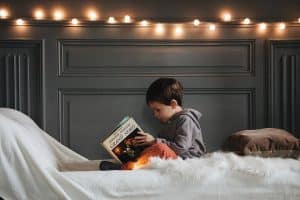
2. Set up a tent (dark den) indoors. Add sleeping bags, pillows, cuddly toys, etc.
3. Give the children torches, glow in the dark stars, glow sticks etc.
4. Emphasise the transition from light to dark/day and night. This will allow the children to develop awareness of time and sequencing from day to night.
5 Facilitate their understanding of day and night by reading day and night stories, pointing out that we go for a walk during the day and sleep at night.
6. Foster the child’s awareness of time and sequencing from day to night by discussing bedtime routines. What do we do before bed, bedtime stories …
Making Soup – Nicola Andrews
A great activity to do together, with a tasty ending.
Learning Intentions
To be able to identify different vegetables and understand that farmers harvest crops to give us food; safely prepare food for cooking – using a knife correctly to cut food; and remember to always wash hands before touching food.
Activity
1. Using a chopping board and an age appropriate knife, allow the children to choose vegetables to cut up to use to make soup.
2. The adult will model how to hold a knife and how to cut the vegetables safely.
3. The vegetables can then be cooked and made into a soup for the children to enjoy.
4. If the child has a play kitchen, then they can pretend to make their own soup.
Nocturnal Habitat – Kerry O’Kane
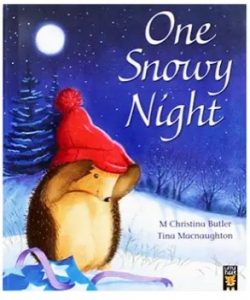 Story book ‘One Snowy night’ by Christina Butler. Talk about how the hedgehog feels and ask children to think of what they could do to make him feel happy.
Story book ‘One Snowy night’ by Christina Butler. Talk about how the hedgehog feels and ask children to think of what they could do to make him feel happy.
Learning intentions
Listen to the story and take part in discussions on nocturnal animals; identify a range of natural resources; and identify their qualities to create their own outdoor nocturnal habitat.
Activity
1. Resources: story can be accessed on Youtube; natural materials from the environment, pipe cleaners and masking tape.
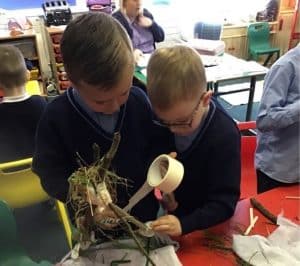 2. Read the story ‘One Snowy night’ to the children.
2. Read the story ‘One Snowy night’ to the children.
3. Ask the children to name different resources they need to collect and support children to talk about the different needs of an animal, e.g. room to get in, somewhere comfortable, a roof to keep dry and somewhere quiet to hide from predators.
4. Collect the resources and build a habitat.
Shop the House – Oonagh McLaughlin
Learning Intention
To understand that money can be used to make purchases.
Activity
1. Create a shop in your home, perhaps with drinks or snacks in the kitchen, although this could also be for certain toys, for TV time, internet time or access to digital devices.
2. Label the ‘goods’ with price tags (perhaps on post-its).
3. Give children a set amount of money and allow them to ‘spend’ their money over the course of the day, counting out the value of coins and calculating the change owed to them.
4. They could also complete tasks around the house and ‘earn’ money to spend on things at home, for instance brushing up, putting rubbish into the bin, drying or putting away dishes.
